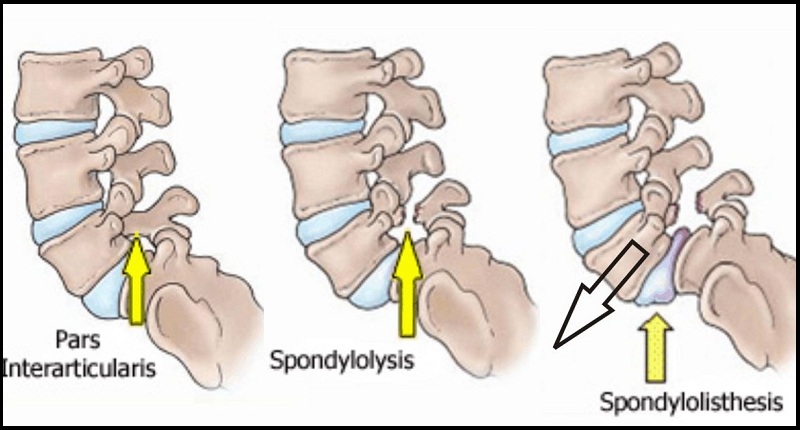Spondylolisthesis is a condition of the spine whereby one of the vertebra slips forward or backward in relation to the next vertebra. Forward slippage of an upper vertebra on a lower vertebra is referred to as anterolisthesis, while backward slippage is referred to as retrolisthesis. Spondylolisthesis can lead to a deformity of the spine as well as a narrowing of the spinal canal (central spinal stenosis) or compression of the exiting nerve roots (foraminal stenosis). Spondylolisthesis is most common in the low back (lumbar spine) but can also occur in the mid to upper back (thoracic spine) and neck (cervical spine).
What causes spondylolisthesis ?
There are five major types of lumbar spondylolisthesis.
- Dysplastic spondylolisthesis: Dysplastic spondylolisthesis is caused by a defect in the formation of part of the vertebra called the facet that allows it to slip forward. This is a condition that a patient is born with (congenital).
- Isthmic spondylolisthesis: In isthmic spondylolisthesis, there is a defect in a portion of the vertebra called the pars interarticularis. If there is a defect without a slip, the condition is called spondylolysis. Isthmic spondylolisthesis can be caused by repetitive trauma and is more common in athletes exposed to hyperextension motions, including gymnasts and football linemen.
- Degenerative spondylolisthesis: Degenerative spondylolisthesis occurs due to arthritic changes in the joints of the vertebrae due to cartilage degeneration and is acquired later in life. Degenerative spondylolisthesis is more common in older patients.
- Traumatic spondylolisthesis: Traumatic spondylolisthesis is due to direct trauma or injury to the vertebrae. This can be caused by a fracture of the pedicle, lamina, or facet joints that allows the front portion of the vertebra to slip forward with respect to the back portion of the vertebra.
- Pathologic spondylolisthesis: Pathologic spondylolisthesis is caused by a defect in the bone caused by abnormal bone, such as from a tumor.
What are the risk factors for spondylolisthesis?
Risk factors for spondylolisthesis include a family history of back problems. People who are born with a defect in the pars interarticularis bone in the spine (a condition called spondylolysis) are at increased risk of isthmic spondylolisthesis. Other risk factors include a history of repetitive trauma or hyperextension of the lower back or lumbar spine. Athletes such as gymnasts, weight lifters, and football linemen who have large forces applied to the spine during extension are at greater risk for developing isthmic spondylolisthesis.
What are spondylolisthesis symptoms?
The most common symptom of spondylolisthesis is lower back pain. This is often worse after exercise especially with extension of the lumbar spine. Other symptoms include tightness of the hamstrings, and stiffness and decreased range of motion of the lower back. Pain in the legs, thighs, and buttocks may worsen with standing. Some patients can develop pain, numbness, tingling, or weakness in the legs due to nerve compression. Severe compression of the nerves can cause loss of control of bowel or bladder function, or cauda equina syndrome.
